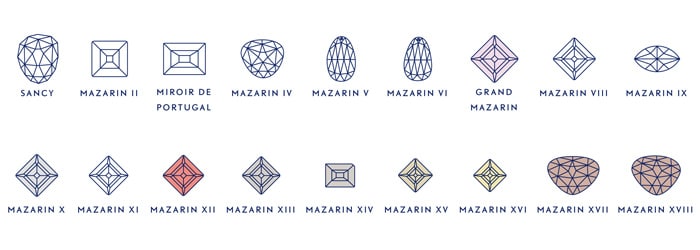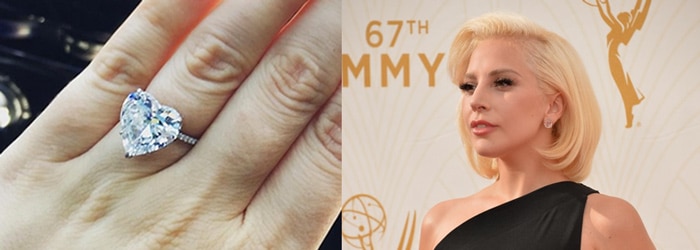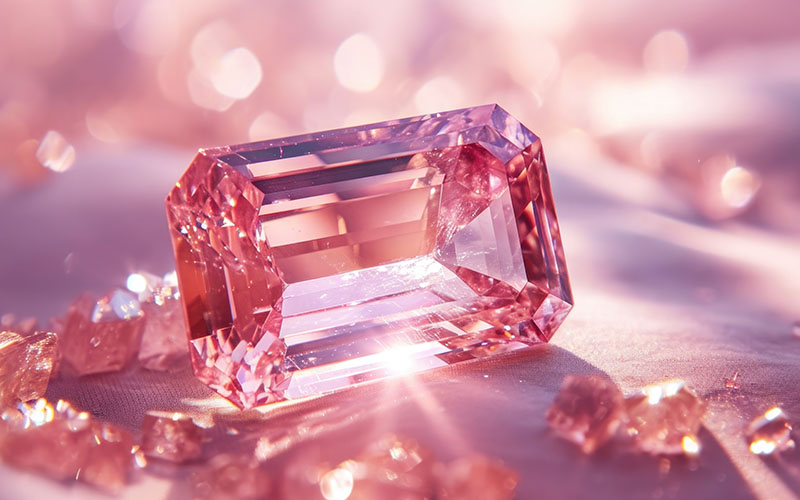Once upon a time…
A lonely rough diamond met another.
The two began growing together. For countless ages they shared their lattices, twinning happily with each other until they were completely joined as one. The final result? An extraordinary, flat, triangle-shaped diamond crystal known as a macle.

Also called twinned crystals, macles are notoriously challenging to fashion because of an internal change in growth direction where they initially joined. Diamond cutters exercise great caution along this “twinning line” since the inadvertent release of strain accumulated over eons of formation could cause the stone to fracture.
Lighthearted profile
Macles have a flat geometry when compared to typical untwinned dodecahedral and octahedral diamond crystals.

Their triangular outlines and low profiles make macles well-suited for producing shallow diamond shapes, such as the heart. Deeper crystals are typically used for producing round brilliants, cushions, princess-cuts and other shapes with more depth.

Macles are also useful for producing trilliants, baguettes, lozenges, kites, etc. And, while shallow shapes do not come from macles, exclusively, it’s a safe bet that no diamond crystal has shown “more heart” over the years than the macle.
Adding to that in human terms, a single, sparkling heart-shaped diamond seems like a storybook ending for two rough crystals that joined and became one.
A ‘hearty’ history
In 1562 Mary Queen of Scots famously gifted Queen Elizabeth of England with a heart-shaped diamond set into a ring. Shortly afterward, Cardinal Richelieu of France gifted his own king with a 20-carat heart-shaped diamond. These royal gestures helped heart-shaped diamonds become recognized as symbols of friendship and goodwill.
In the 17th century Cardinal Mazarin (protege and successor of Cardinal Richelieu), who introduced the brilliant style of diamond cutting, included heart-shaped rose cuts, items XVII and XVIII, as the final choices for his famous diamond collection.

See more famous diamonds, including the world’s largest fancy vivid purple heart shape, in a photo collection covering these Top 10 World-Famous or Largest Diamonds.
Sweet Hearts
Our Valentine’s Day story continues with a look at some celebrated heart shapes.
- Some are old
- Some are new
- Some are borrowed
- And (you guessed it) some are blue
The Blue Heart
The Blue Heart Diamond is on display at The Smithsonian. Unearthed at the Premier mine in South Africa in 1908, the original rough crystal weighed over 100 carats. The object of great attention over the years, this distinctive 30.62 carat blue diamond passed through the hands of Pierre Cartier, Van Cleef & Arpels and Harry Winston, among others. Marjorie Merriweather Post, its last private owner, purchased the Blue Heart from Harry Winston and generously gifted it to the National Gem Collection in 1964. Assessed with a clarity grade of VS2, The Blue Heart’s distinctive natural deep fancy blue color is caused by trace amounts of boron.

The Cullinan V
The largest gem-quality diamond ever discovered remains the 3,106.75 carat Cullinan. It was gifted to the United Kingdom by the South African government and cut into many smaller diamonds, of which nine have the most prominence. The Cullinan V finished as an 18.8 carat heart-shaped diamond. It has seen great exposure over the years and continues to be worn today, borrowed by Queen Mary’s granddaughter when not being worn by Her Royal Majesty, Queen Elizabeth II.

Incidentally, South Africa’s Premier diamond mine, which produced both the Cullinan V and The Blue Heart, was renamed “The Cullinan Mine” on its centenary celebration in 2003.
Going GaGa
On Valentine’s Day in 2015 a young man named Taylor asked his longtime lady Stefani to marry him, proposing with a stunning 6 carat heart-shaped diamond. That lady was, of course, Lady Gaga. The engagement did not last, however… (wait for it) …a diamond is forever.
Created by Jeweler Lorraine Schwartz, GaGa’s stunningly symmetrical sparkler was set into a classic solitaire with pave’ side diamonds. At the time of the proposal it was valued at 500,000 British pounds.

The Gruosi
A labor of love undertaken by diamantaire Fawaz Gruosi, the largest black heart-shaped diamond is The Gruosi. The rough diamond it was produced from weighed a staggering 300.12 carats, but the porosity of carbonado black diamond made the material extremely fragile during cutting, resulting in a finished diamond of 115.34 carats. The Gruosi is mounted in a necklace featuring 378 white diamonds, 58.77 carats of smaller carbonado black diamonds and 14.10 carats of tsavorite garnets. You can discover “The Secret of black diamonds” such as the Gruosi, the 3,575 adorning the 2008 Victoria’s Secret Fantasy bra and the magnificent 300 carats worn to the Grammy Awards by Lady Gaga in a prior IGI GemBlog post, here.

Christie’s Heart
Predicted to sell for $10 million dollars in 2011, this stunning D color, internally flawless 56-carat heart shaped diamond shocked the diamond world when it sold for $12 million dollars at the 2011 “Christie’s Magnificent Jewels” auction. That amount remains the most money ever paid for a heart-shaped diamond.

The Royal Purple Heart
Natural purple diamonds are among the rarest fancy colored diamonds in existence and the 7.34 carat Royal Purple Heart is the world’s largest fancy vivid purple diamond. Cut by the Julius Klein Diamond Corporation, the Royal Purple Heart’s origins are unknown, but experts believe it was discovered in Russia.

The Argyle Amour
The Argyle Amour is the most valuable heart-shaped diamond to come from the Argyle Diamond Mine in Western Australia. The Argyle mine yields the planet’s only source of diamonds found in Lamproite pipes. The world’s other diamondiferous formations formed in Kimberlite. Weighing 2.61 carats, the Argyle Amour’s distinctive pink color manifests as a result of structural changes in the crystal lattice, caused by enormous forces of pressure during its formation.

“Amour” is the French word for love. And a pink heart-shaped diamond is the perfect icon with which to finish our Valentine’s Day story.
…and they lived happily ever after
You are invited to share this romantic, forever-story of macles, diamonds and amour with your own loved ones on this special day. Unless you don’t have the ‘heart’ for it 😉
Happy Valentine’s Day.




